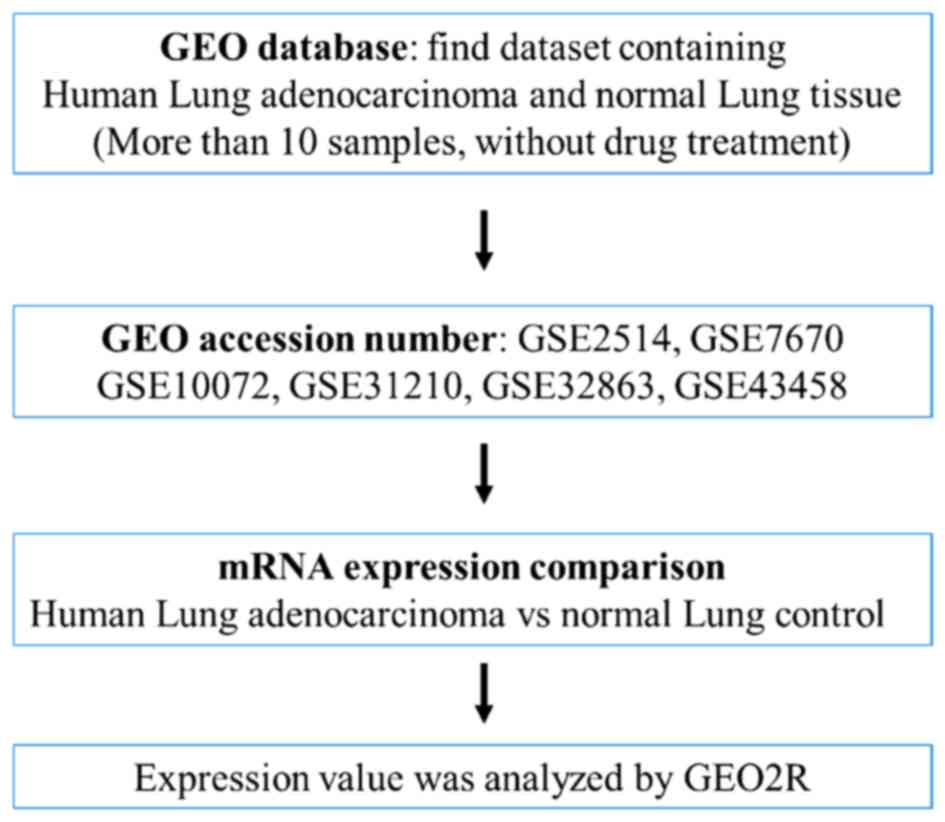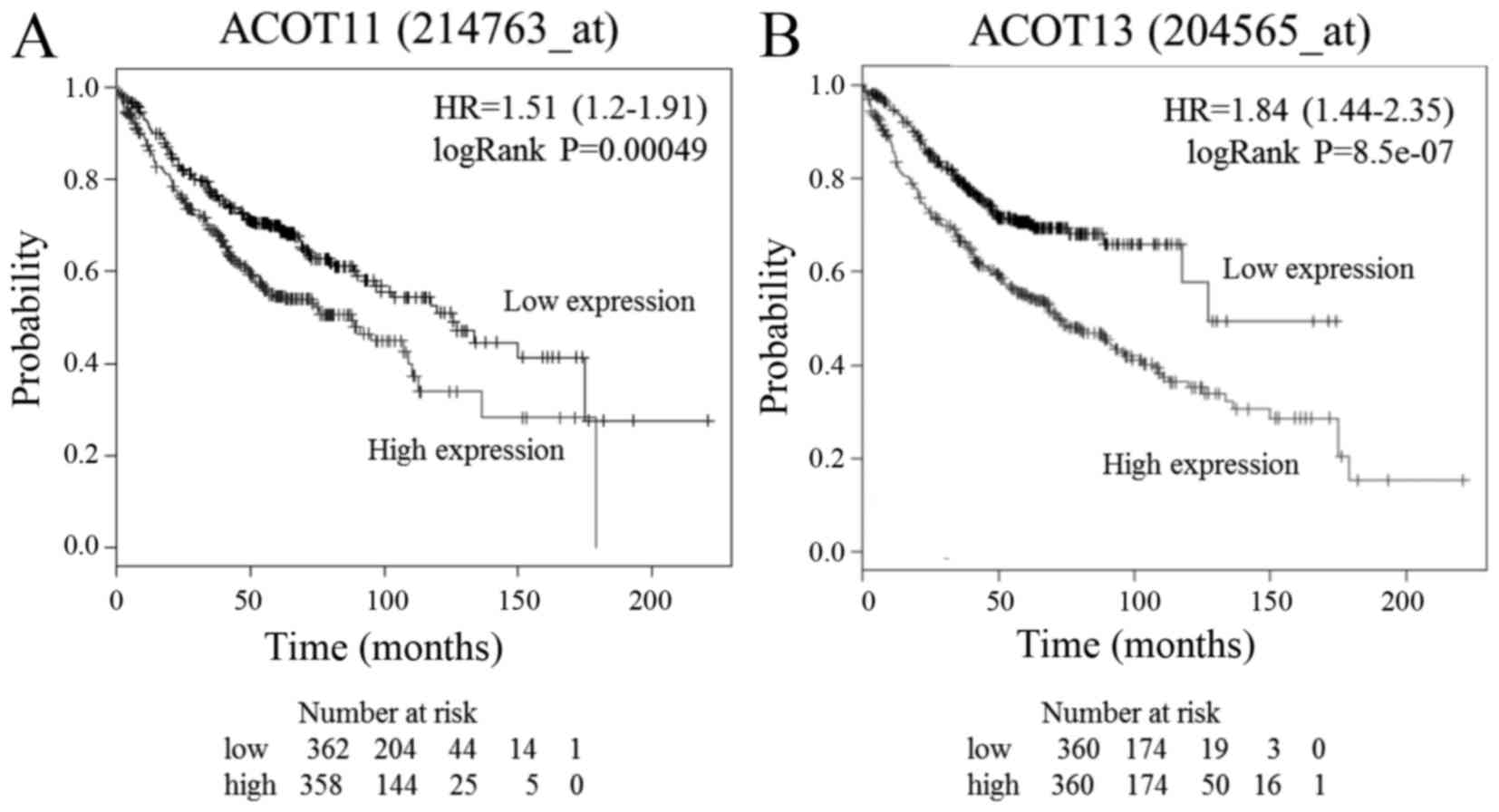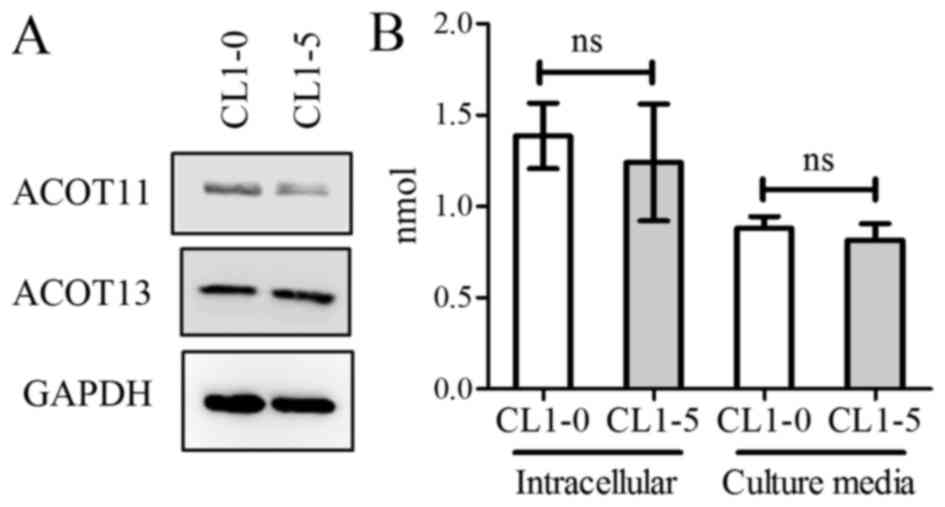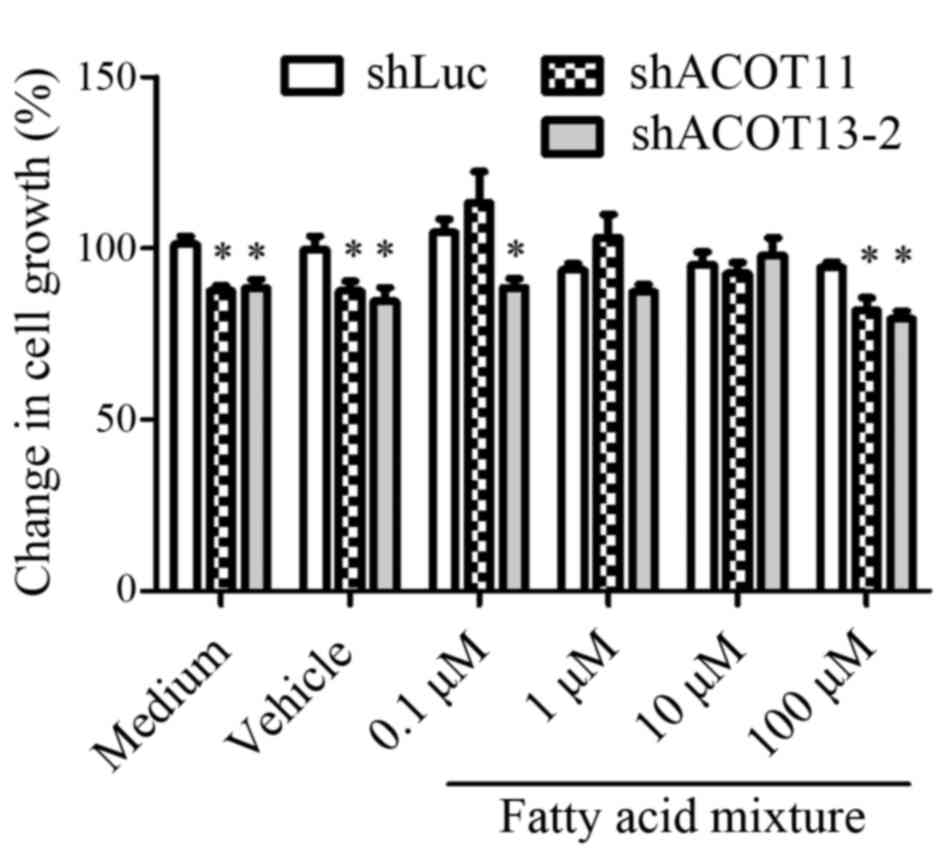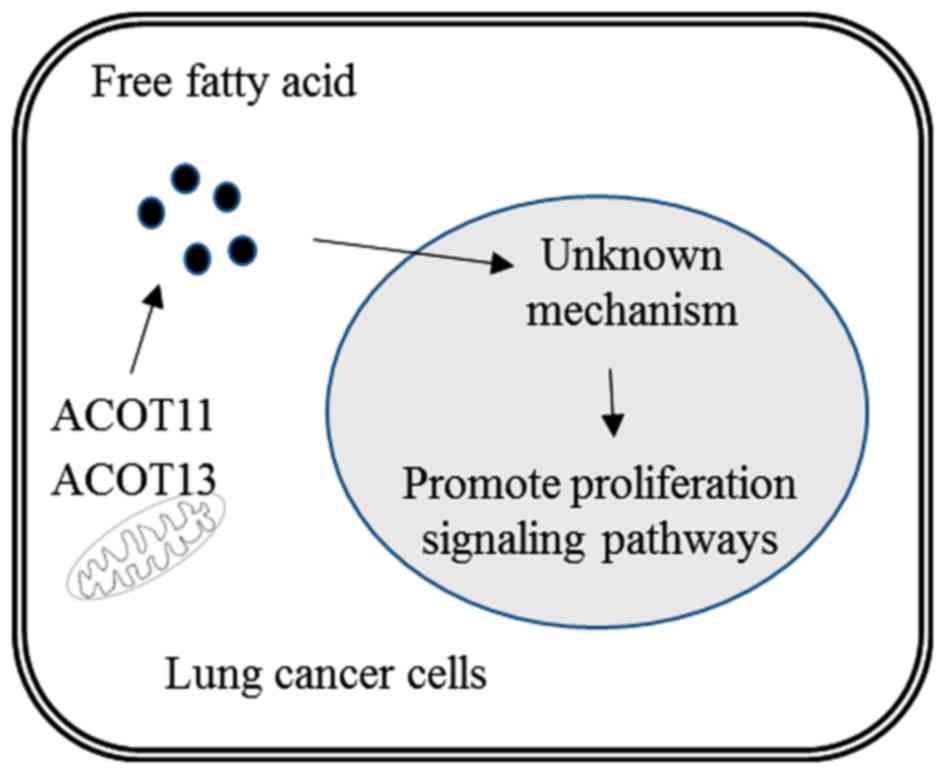Overexpression and proliferation dependence of acyl‑CoA thioesterase 11 and 13 in lung adenocarcinoma
- Authors:
- Published online on: July 18, 2017 https://doi.org/10.3892/ol.2017.6594
- Pages: 3647-3656
Abstract
Introduction
Metabolites are currently considered targets for cancer treatments, particularly amino acids and glucose (1). Fatty acyl-Coenzyme A (CoA) esters are essential components in lipid metabolism and are regulators of multiple cellular functions (2). Enzymes of the acyl-CoA synthetase (ACS) family, including the ACS long-chain, ACS medium-chain, ACS short-chain and ACS bubblegum families, ligate different lengths of fatty acid with CoA. Fatty acyl-CoA esters are hydrolyzed into free fatty acids and CoA by enzymes of the acyl-CoA thioesterase (ACOT) family (3,4). There are >15 ACOT enzymes and 20 ACS enzymes in humans, and these enzymes exhibit different tissue distribution, subcellular location and substrate specificity (3,4).
Lung cancer is a leading cause of cancer-associated mortality and is the second most commonly diagnosed cancer (5). The majority (~85–90%) of diagnosed cases of lung cancer are diagnosed as non-small cell lung cancer (NSCLC) and adenocarcinoma is the most common subtype of NSCLC (6). Compared with healthy individuals, patients with lung adenocarcinoma possess a significantly higher level of fatty acids (including arachidonic, palmitic, linoleic and oleic acid) in their plasma (7,8). In addition, overexpression of ACOT8 is associated with metastasis in lung adenocarcinoma (9). However, the cellular functions and the regulatory mechanisms of the majority of ACOT and ACS enzymes in lung adenocarcinoma remain unclear. In the present study, in order to systematically analyze the expression pattern of these enzymes, expression levels of ACOT and ACS enzymes were analyzed in clinical specimens of lung adenocarcinoma from six microarray datasets that were collected from an online database. In addition, the effect of these enzymes and their metabolic products on cell proliferation was measured in lung adenocarcinoma cell lines.
Materials and methods
Collection of microarray datasets of human lung adenocarcinoma specimens
Expression profiling microarray data of human lung adenocarcinoma clinical specimens, which was published between 2005 and 2015, was collected from the National Center for Biotechnology Information Gene Expression Omnibus (GEO, http://www.ncbi.nlm.nih.gov/geo/) (10). Microarray data from cell lines or small sample sizes (<10 samples) were excluded. Six microarray datasets including GSE2514 (11), GSE7670 (12), GSE10072 (13), GSE31210 (14), GSE32863 (15), and GSE43458 (16) were collected and the relative expression levels of fatty acyl-CoA metabolic enzymes between adjacent non-tumor lung tissue and lung adenocarcinoma were analyzed in these microarray datasets. The expression value was analyzed using the GEO2R interface (http://www.ncbi.nlm.nih.gov/geo/geo2r/).
Kaplan Meier (KM)-Plotter
The survival analysis in lung adenocarcinoma patients with different expression levels of ACOT11 and ACOT13 was performed using the KM-Plotter database (17). The prognostic value of each gene was analyzed by splitting patient samples into two groups according to median expression. After the subtype of lung cancer was restricted (‘Histology: adenocarcinoma’) and survival rate was analyzed through the ‘2015 version’ database and ‘excluded biased array’, 720 patients were analyzed.
Chemicals
Dimethyl sulfoxide (DMSO), puromycin, myristic acid, palmitic acid and stearic acid were purchased from Sigma-Aldrich (Merck KGaA, Darmstadt, Germany). Myristic acid, and palmitic acid and stearic acid were dissolved in DMSO.
Cell culture
Human lung adenocarcinoma cell lines CL1-0 and CL1-5 were provided by Dr Pan-Chyr Yang (Department of Internal Medicine, National Taiwan University Hospital, Taipei, Taiwan) and were cultured in RPMI-1640 supplemented with 10% fetal bovine serum and 1% penicillin-streptomycin (all Thermo Fisher Scientific, Inc., Waltham, MA, USA) in a humidified incubator at 37°C with 5% CO2 (18,19).
Short hairpin (sh)RNA and transfection
shRNA targeting ACOT11 (shACOT11; TRCN0000048912; targeting sequence: 5′-GTCTCCTCCTTGAAGATGCT-3′), ACOT13 (shACOT13-1; TRCN0000048954; targeting sequence: 5′-CGATATGAACATAACGTACAT-3′; shACOT13-2; targeting sequence: TRCN0000048956; targeting sequence: 5′-GAAGAGCATACCAATGCAATA-3′) and a negative control construct (luciferase shRNA, shLuc) were obtained from the National Core Facility for Manipulation of Gene Function by RNAi, miRNA, miRNA sponges, and CRISPR/Genomic Research Center, Academia Sinica (Taipei, Taiwan). CL1-0 and CL1-5 cells were transfected with each shRNA plasmid using Lipofectamine® 2000 reagent (Invitrogen; Thermo Fisher Scientific, Inc.) according to the manufacturer's protocol. Transfected cells were selected and maintained in medium containing 2 µg/ml puromycin.
Reverse transcription-quantitative polymerase chain reaction (RT-qPCR)
Total RNA was extracted from cells using TRIzol reagent (Invitrogen; Thermo Fisher Scientific, Inc.) according to manufacturer's protocol. Complementary DNA (cDNA) was reverse transcribed from mRNA using the PrimeScript RT reagent kit (Clontech Laboratories, Inc., Mountainview, CA, USA) according to the manufacturer's protocol. PCR was performed using the following primers: ACOT13 forward, 5′-TCTGCTATGCACGGAAAGGG-3′ and reverse, 5′-TTTCCTGTGGCCTTGTTGGT-3′; ACOT11 forward, 5′- GCG ATC TGG AGA GCA GAG AC-3′ and reverse, 5′-GTGGCCACATTCTCCATCCA-3′; GAPDH forward, 5′-GAGTCAACGGATTTGGTCGT-3′ and reverse, 5′-TTGATTTTGGAGGGATCTCG-3′. PCR was performed on a StepOne Plus Real-Time PCT System (Applied Biosystems; Thermo Fisher Scientific, Inc.) using the Fast SYBR Green Master Mix (Applied Biosystems; Thermo Fisher Scientific, Inc.). The following settings were used: 1 cycle of 95°C for 20 sec, and 40 cycles of 95°C for 3 sec and 60°C for 30 sec. The mRNA expression levels were normalized to the expression level of GAPDH using the 2−∆∆Cq method (20).
Western blot analysis
Cells were lysed in radioimmunoprecipitation assay buffer (EMD Millipore, Billerica, MA, USA) and the total cell lysate was collected by centrifugation at 4°C, 12,000 × g for 15 min. Quantification of protein concentration was performed using a BCA protein assay kit (EMD Millipore). A total of 30 µg/lane protein was loaded, subjected to 10% SDS-PAGE and transferred to polyvinylidene difluoride membranes (EMD Millipore). Membranes were blocked with 5% dried skimmed milk in Tris-buffered saline with Tween-20 buffer and then incubated with the primary antibodies overnight at 4°C. Protein expression was detected using the following primary antibodies: Anti-ACOT11 (dilution, 1:3,000; cat. no. ab153835), anti-ACOT13 (dilution, 1:1,000; cat. no. ab166684; both Abcam, Cambridge, UK) and anti-GAPDH (dilution, 1:6,000; cat. no. MAB374; EMD Millipore). Each membrane was then incubated with secondary andibodies, including peroxidase conjugated goat anti-rabbit IgG (dilution, 1:5,000; cat. no. AP132P) and peroxidase conjugated goat anti-mouse IgG, (dilution, 1:5,000; cat. no. AP124P; both EMD Millipore) at room temperature for 1 h. Immunoreactive signals were detected with Immobilon horseradish peroxidase substrate enhanced chemiluminescence reagents (EMD Millipore) and analyzed with the Alpha Innotech FluorChem FC2 imaging system (ProteinSimple; Bio-Techne, Minneapolis, MN, USA).
Cell proliferation assay
For cell proliferation measurements, WST-1 (Clontech Laboratories, Inc.) was used. A total of 5×103 CL1-0 or 2.5×103 CL1-5 cells were seeded in 96-well plates. The proliferation rate was determined at a wavelength of 450 nm on a microplate spectrophotometer (PowerWave X340, BioTek Instruments, Inc., Winooski, VT, USA).
Free fatty acid quantification
A total of 1×106 CL1-0 cells were seeded into 10 cm dishes with 8 ml of culture medium. After 48 h, culture medium and cells were collected for free fatty acid quantification. Free fatty acids released into the culture medium and intracellular free fatty acid were quantified using a Free Fatty Acid Quantification Colorimetric/Fluorometric kit (BioVision, Inc., Milpitas, CA, USA) according to the manufacturer's protocol. The results were determined on a fluorescent microplate reader at excitation/emission=485/590 nm (FLX800 Microplate Fluorescence Reader; BioTek Instruments, Inc.).
Statistical analysis
All statistical analyses were performed using GraphPad Prism software (version 5.03; GraphPad Software, Inc., La Jolla, CA, USA). All error bars in the figures represent standard error of the mean. The differences between two independent groups were analyzed using a Student's t-test. A log-rank test was performed to assess differences in survival rate. P<0.05 was considered to indicate a statistically significant difference.
Results
High ACOT11 and ACOT13 expression is associated with lung adenocarcinoma and poor overall survival rate
To investigate whether the expression of ACSs and ACOTs was associated with lung adenocarcinoma, microarray datasets with lung adenocarcinoma specimens were collected from the GEO database. Following the exclusion of microarray data regarding cell line studies and small sample sizes (<10 samples), six microarrays that were performed by five different array platforms were selected for the current study (Fig. 1). A number of enzymes were significantly differentially expressed in lung adenocarcinoma tissue compared with non-tumor lung tissue (Tables I and II). ACOT11 and ACOT13 overexpression was observed in lung adenocarcinoma tissue across all selected microarray datasets (Table I). A KM-Plotter database was used to further investigate the association between the expression of ACOT11 and ACOT13 and clinical outcome. Poor overall survival rate of patients with lung adenocarcinoma was associated with high expression of ACOT11 and ACOT13 (P<0.001; Fig. 2). These results suggest that ACOT11 and ACOT13 serve roles in the development of lung adenocarcinoma.
Table I.mRNA expression of ACOT enzymes in lung adenocarcinoma tissue compared with normal tissue, from the GEO database. |
Table II.mRNA expression of ACS enzymes in lung adenocarcinoma tissue compared with normal tissue, from the GEO database. |
ACOT11 and ACOT13 knockdown decreases cell proliferation but does not affect the level of free fatty acids
The CL1-0 and CL1-5 cell lines were established from a patient with lung adenocarcinoma and exhibit different invasive and metastatic properties (19). Similar protein levels of ACOT11 and ACOT13, and similar levels of intracellular and medium free fatty acid, were observed in the two cell lines (Fig. 3A and B). In order to determine the role of ACOT11 and ACOT13, shRNAs targeting ACOT11 (shACOT11) and ACOT13 (shACOT13-1 and shACOT13-2) were transfected into CL1-0 and CL1-5 cells. Cells treated with shACOT11 exhibited significantly decreased expression of ACOT11 (P<0.05; Fig. 4A). Similarly, cells treated with shACOT13-1/−2 exhibited significantly decreased expression of ACOT13 (P<0.01 and P<0.001, respectively; Fig. 4A). These changes were also exhibited at the protein level (Fig. 4B). Although decreasing expression of ACOT11 and ACOT13 did not result in a significant change in total free fatty acids (Fig. 4C), significantly decreased proliferation rates were observed in CL1-0 and CL1-5 cells treated with shACOT11 compared with the control (P<0.001 and P<0.01, respectively; Fig. 4D). In addition, CL1-0 cells treated with shACOT13-2, and CL1-5 cells treated with ahACOT13-1 exhibited significantly decreased proliferation rates compared with the control (P<0.001 and P<0.05, respectively; Fig. 4D). These results suggest that ACOT11 and ACOT13 are critical for proliferation in lung adenocarcinoma cell lines.
Free fatty acid supplements rescue the decreased proliferation rate induced by ACOT11 and ACOT13 knockdown
ACOT11 and ACOT13 are members of the Type II ACOT family (21). The substrates of ACOT11 and ACOT13 include medium (6–12 carbon) to long (13–21 carbon) chain acyl CoA (22). It was hypothesized that the observed decreased proliferation rates following ACOT11/13 knockdown were associated with insufficient availability of free fatty acids. Therefore ACOT11/13 knockdown CL1-0 cells were treated with a fatty acid mixture, including myristic (C14:0), palmitic (C16:0) and stearic acid (C18:0). The cell proliferation rate was significantly decreased in the control groups (medium and vehicle) following treatment with shACOT11/13-2 compared with the control luciferase shRNA group (P<0.05; Fig. 5); however, treatment with the fatty acid mixture (0.1–10 µM) restored shACOT11 and shACOT13-mediated growth inhibition. However, this effect was abolished following the addition of mixed free fatty acids at the highest dose (100 µM), which may indicate a negative feedback mechanism. The results suggest that the proliferation of lung adenocarcinoma cells is dependent on ACOT11 and ACOT13-mediated metabolic products.
Discussion
Dysregulation of metabolism is a hallmark of cancer development. Acyl-CoAs are involved in the biosynthesis of lipids, signal transduction and gene transcription (23). Previous studies have demonstrated that certain types of fatty acid are increased in the serum or plasma of patients with lung adenocarcinoma (7,8). Notably, the level of fatty acids (palmitic, stearic, oleic, linoleic, arachidonic and palmitoleic acid) decreased in the serum of patients with lung cancer compared with the healthy controls (24). This suggests that different types of lung cancer may possess unique metabolic networks. Although previous studies have demonstrated associations between a single enzyme and a specific tumor type, including the association between ACSL3, ACOT8 and liver cancer (25,26), very long-chain ACS-3 (ACSVL3) and lung cancer (27), and ACOT8 and metastatic lung adenocarcinoma (9), the associations between types of tumor and the enzyme network of acyl-CoA and acyl-CoA esters remain unclear. To systematically determine the potential roles of all ACS and ACOT enzymes in lung adenocarcinoma, the gene expression values from six different microarray datasets were analyzed using five different platforms. Several enzymes exhibited significantly different expression levels between normal and lung adenocarcinoma tissue. High expression of ACOT11 and ACOT13 was observed in tumors compared with normal tissue in each dataset. KM-Plotter analysis demonstrated that high ACOT11/13 expression was correlated with poor overall survival rate. Since the criteria was not restricted to metastatic lung adenocarcinoma, ACOT8 expression levels in tumor tissue were not significantly different compared with normal tissue in the present study. These results indicated that ACOT11 and ACOT13 enzymes are potential oncogenes in lung adenocarcinoma.
ACOT11 is highly expressed in brown adipose tissue compared with other tissues (28). The ACOT11 structure comprises two ‘hotdog’ domains and a C-terminal lipid-binding steroidogenic acute regulatory transfer-related (START) domain (22). Although a previous study suggested that the START domain may be an important regulatory element for ACOT11 (29), the exact mechanisms underlying the regulation and function of ACOT11 remain unknown in lung adenocarcinoma and other tissues. ACOT11 knockout mice revealed increased energy consumption and resistance to high fat diet-induced obesity compared with control mice (30). In addition, loss of ACOT11 leads to resistance to obesity-induced inflammation and endoplasmic reticulum stress (30). A high fat diet significantly induced ACOT11 expression in mouse liver (3). These observations suggest that ACOT11 expression may serve as a risk factor for obesity. The results from the present study demonstrate that ACOT11 expression is associated with cell proliferation, suggesting that inhibition of ACOT11 may be a strategy to treat lung adenocarcinoma.
AOCT13 comprises a single ‘hotdog’ domain and is expressed in a number of tissues, including liver, heart, kidney and brown adipose tissue (3). In ACOT13 knockout mice, increasing concentrations of long-chain fatty acyl-CoA and decreasing concentrations of free fatty acids is detected in the liver (31). When mice are fed with a high-fat diet, ACOT13 knockout mice resist increases in glucose production in the liver (31). This observation suggests that ACOT13 serves a role in the regulation of lipid and glucose metabolism in the liver. Notably, ACOT13 interacts with phosphatidylcholine transfer protein (PC-TP), which possesses a START domain (32). Addition of recombinant PC-TP increases ACOT13 enzyme activity in vitro (32). The interaction affects the transcriptional activity of peroxisome proliferator-activated receptor alpha and hepatocyte nuclear factor 4 alpha in the liver (33). Since ACOT11 contains a START domain, these observations imply that ACOT13 may also interact with ACOT11. Since overexpression of ACOT11 and ACOT13 was observed in the present study, these interactions may regulate critical biological functions in lung adenocarcinoma.
The level of free fatty acids is significantly altered in brown adipose tissue and liver in ACOT11 and ACOT13 knockout mice, respectively (30,31). However, in the present study, ACOT11 and ACOT13 knockdown did not affect the level of total amount of free fatty acid in CL1-0 cells. There are two possible reasons for this. First, ACOT11 and ACOT13 may not be major lipid-metabolic enzymes in the lung adenocarcinoma cell. Decreasing levels of ACOT11 and ACOT13-hydrolyzed free fatty acids (medium to long-chain) may account for a small part of the total free fatty acid pool. Second, free fatty acids may be adequately supplied from the culture medium. Although ACOT11 and ACOT13 knockdown results in the reduction of certain types of free fatty acid, the effect may be diluted in the free fatty acid pool. Addition of free fatty acid mixture restored the growth inhibition. The results suggest that metabolic products of ACOT11 and ACOT13 (14 to 18 carbon) are important regulators for lung adenocarcinoma. The findings are summarized in Fig. 6.
In conclusion, the results from the present study reported the role of ACOT11 and ACOT13 in lung adenocarcinoma. High ACOT11 and ACOT13 expression was associated with lung adenocarcinoma and poor overall survival rate. Knockdown of ACOT11 and ACOT13 significantly decreased cell proliferation, an effect that could be rescued by supplementing cells with free fatty acids. To the best of our knowledge, this is the first report regarding the potential oncogenic properties of ACOT11 and ACOT13 in lung adenocarcinoma. ACOT11 and ACOT13 may represent targets for novel treatments for patients with lung adenocarcinoma.
Acknowledgments
The present study was supported by grants from the Ministry of Science and Technology of the Republic of China (grant nos. MOST 103-2320-B-037-006-MY3 and MOST 104-2314-B-037-053-MY4), the KMU-KMUH Co-Project of Key Research (grant no. KMU-DK 105002 from Kaohsiung Medical University) and the Chi-Mei Medical Center and Kaohsiung Medical University Research Foundation (grant no. HSU 104CM-KMU-01).
References
|
Tennant DA, Durán RV and Gottlieb E: Targeting metabolic transformation for cancer therapy. Nat Rev Cancer. 10:267–277. 2010. View Article : Google Scholar : PubMed/NCBI | |
|
Faergeman NJ and Knudsen J: Role of long-chain fatty acyl-CoA esters in the regulation of metabolism and in cell signalling. Biochem J. 323:1–12. 1997. View Article : Google Scholar : PubMed/NCBI | |
|
Ellis JM, Bowman CE and Wolfgang MJ: Metabolic and tissue-specific regulation of acyl-CoA metabolism. PLoS One. 10:e01165872015. View Article : Google Scholar : PubMed/NCBI | |
|
Hunt MC, Tillander V and Alexson SE: Regulation of peroxisomal lipid metabolism: The role of acyl-CoA and coenzyme A metabolizing enzymes. Biochimie. 98:45–55. 2014. View Article : Google Scholar : PubMed/NCBI | |
|
Siegel RL, Miller KD and Jemal A: Cancer statistics, 2015. CA Cancer J Clin. 65:5–29. 2015. View Article : Google Scholar : PubMed/NCBI | |
|
World Health Organisation, . World Cancer Report 2014. Chapter 5.1. 2014. | |
|
Wen T, Gao L, Wen Z, Wu C, Tan CS, Toh WZ and Ong CN: Exploratory investigation of plasma metabolomics in human lung adenocarcinoma. Mol Biosyst. 9:2370–2378. 2013. View Article : Google Scholar : PubMed/NCBI | |
|
Liu J, Mazzone PJ, Cata JP, Kurz A, Bauer M, Mascha EJ and Sessler DI: Serum free fatty acid biomarkers of lung cancer. Chest. 146:670–679. 2014. View Article : Google Scholar : PubMed/NCBI | |
|
Jung WY, Kim YH, Ryu YJ, Kim BH, Shin BK, Kim A and Kim HK: Acyl-CoA thioesterase 8 is a specific protein related to nodal metastasis and prognosis of lung adenocarcinoma. Pathol Res Pract. 209:276–283. 2013. View Article : Google Scholar : PubMed/NCBI | |
|
Barrett T, Wilhite SE, Ledoux P, Evangelista C, Kim IF, Tomashevsky M, Marshall KA, Phillippy KH, Sherman PM, Holko M, et al: NCBI GEO: Archive for functional genomics data sets-update. Nucleic Acids Res. 41:(Database issue). D991–D995. 2013. View Article : Google Scholar : PubMed/NCBI | |
|
Stearman RS, Dwyer-Nield L, Zerbe L, Blaine SA, Chan Z, Bunn PA Jr, Johnson GL, Hirsch FR, Merrick DT, Franklin WA, et al: Analysis of orthologous gene expression between human pulmonary adenocarcinoma and a carcinogen-induced murine model. Am J Pathol. 167:1763–1775. 2005. View Article : Google Scholar : PubMed/NCBI | |
|
Su LJ, Chang CW, Wu YC, Chen KC, Lin CJ, Liang SC, Lin CH, Whang-Peng J, Hsu SL, Chen CH and Huang CY: Selection of DDX5 as a novel internal control for Q-RT-PCR from microarray data using a block bootstrap re-sampling scheme. Bmc Genomics. 8:1402007. View Article : Google Scholar : PubMed/NCBI | |
|
Landi MT, Dracheva T, Rotunno M, Figueroa JD, Liu H, Dasgupta A, Mann FE, Fukuoka J, Hames M, Bergen AW, et al: Gene expression signature of cigarette smoking and its role in lung adenocarcinoma development and survival. PLoS One. 3:e16512008. View Article : Google Scholar : PubMed/NCBI | |
|
Okayama H, Kohno T, Ishii Y, Shimada Y, Shiraishi K, Iwakawa R, Furuta K, Tsuta K, Shibata T, Yamamoto S, et al: Identification of genes upregulated in ALK-positive and EGFR/KRAS/ALK-negative lung adenocarcinomas. Cancer Res. 72:100–111. 2012. View Article : Google Scholar : PubMed/NCBI | |
|
Selamat SA, Chung BS, Girard L, Zhang W, Zhang Y, Campan M, Siegmund KD, Koss MN, Hagen JA, Lam WL, et al: Genome-scale analysis of DNA methylation in lung adenocarcinoma and integration with mRNA expression. Genome Res. 22:1197–1211. 2012. View Article : Google Scholar : PubMed/NCBI | |
|
Kabbout M, Garcia MM, Fujimoto J, Liu DD, Woods D, Chow CW, Mendoza G, Momin AA, James BP, Solis L, et al: ETS2 mediated tumor suppressive function and MET oncogene inhibition in human non-small cell lung cancer. Clin Cancer Res. 19:3383–3395. 2013. View Article : Google Scholar : PubMed/NCBI | |
|
Győrffy B, Surowiak P, Budczies J and Lánczky A: Online Survival Analysis Software to Assess the Prognostic Value of Biomarkers Using Transcriptomic data in Non-Small-Cell Lung Cancer. PLoS One. 8:e822412013. View Article : Google Scholar : PubMed/NCBI | |
|
Kao YR, Shih JY, Wen WC, Ko YP, Chen BM, Chan YL, Chu YW, Yang PC, Wu CW and Roffler SR: Tumor-associated antigen L6 and the invasion of human lung cancer cells. Clin Cancer Res. 9:2807–2816. 2003.PubMed/NCBI | |
|
Chu YW, Yang PC, Yang SC, Shyu YC, Hendrix MJ, Wu R and Wu CW: Selection of invasive and metastatic subpopulations from a human lung adenocarcinoma cell line. Am J Respir Cell Mol Biol. 17:353–360. 1997. View Article : Google Scholar : PubMed/NCBI | |
|
Livak KJ and Schmittgen TD: Analysis of relative gene expression data using real-time quantitative PCR and the 2(−Delta Delta C(T)) Method. Methods. 25:402–408. 2001. View Article : Google Scholar : PubMed/NCBI | |
|
Kirkby B, Roman N, Kobe B, Kellie S and Forwood JK: Functional and structural properties of mammalian acyl-coenzyme A thioesterases. Prog Lipid Res. 49:366–377. 2010. View Article : Google Scholar : PubMed/NCBI | |
|
Cohen DE: New players on the metabolic stage: How do you like Them Acots? Adipocyte. 2:3–6. 2013. View Article : Google Scholar : PubMed/NCBI | |
|
Hunt MC and Alexson SE: The role Acyl-CoA thioesterases play in mediating intracellular lipid metabolism. Prog Lipid Res. 41:99–130. 2002. View Article : Google Scholar : PubMed/NCBI | |
|
Li Y, Song X, Zhao XJ, Zou LJ and Xu GW: Serum metabolic profiling study of lung cancer using ultra high performance liquid chromatography/quadrupole time-of-flight mass spectrometry. J Chromatogr B Analyt Technol Biomed Life Sci. 966:147–153. 2014. View Article : Google Scholar : PubMed/NCBI | |
|
Chang YS, Tsai CT, Huangfu CA, Huang WY, Lei HY, Lin CF, Su IJ, Chang WT, Wu PH, Chen YT, et al: ACSL3 and GSK-3β are essential for lipid upregulation induced by endoplasmic reticulum stress in liver cells. J Cell Biochem. 112:881–893. 2011. View Article : Google Scholar : PubMed/NCBI | |
|
Hung YH, Chan YS, Chang YS, Lee KT, Hsu HP, Yen MC, Chen WC, Wang CY and Lai MD: Fatty acid metabolic enzyme acyl-CoA thioesterase 8 promotes the development of hepatocellular carcinoma. Oncol Rep. 31:2797–2803. 2014.PubMed/NCBI | |
|
Pei Z, Fraisl P, Shi X, Gabrielson E, Forss-Petter S, Berger J and Watkins PA: Very Long-Chain Acyl-CoA Synthetase 3: Overexpression and Growth Dependence in Lung Cancer. PLoS One. 8:e693922013. View Article : Google Scholar : PubMed/NCBI | |
|
Adams SH, Chui C, Schilbach SL, Yu XX, Goddard AD, Grimaldi JC, Lee J, Dowd P, Colman S and Lewin DA: BFIT, a unique acyl-CoA thioesterase induced in thermogenic brown adipose tissue: Cloning, organization of the human gene and assessment of a potential link to obesity. Biochem J. 360:135–142. 2001. View Article : Google Scholar : PubMed/NCBI | |
|
Thorsell AG, Lee WH, Persson C, Siponen MI, Nilsson M, Busam RD, Kotenyova T, Schüler H and Lehtiö L: Comparative structural analysis of lipid binding START domains. PLoS One. 6:e195212011. View Article : Google Scholar : PubMed/NCBI | |
|
Zhang Y, Li Y, Niepel MW, Kawano Y, Han S, Liu S, Marsili A, Larsen PR, Lee CH and Cohen DE: Targeted deletion of thioesterase superfamily member 1 promotes energy expenditure and protects against obesity and insulin resistance. Proc Natl Acad Sci USA. 109:5417–5422. 2012. View Article : Google Scholar : PubMed/NCBI | |
|
Kang HW, Niepel MW, Han S, Kawano Y and Cohen DE: Thioesterase superfamily member 2/acyl-CoA thioesterase 13 (Them2/Acot13) regulates hepatic lipid and glucose metabolism. FASEB J. 26:2209–2221. 2012. View Article : Google Scholar : PubMed/NCBI | |
|
Wei J, Kang HW and Cohen DE: Thioesterase superfamily member 2 (Them2)/acyl-CoA thioesterase 13 (Acot13): A homotetrameric hotdog fold thioesterase with selectivity for long-chain fatty acyl-CoAs. Biochem J. 421:311–322. 2009. View Article : Google Scholar : PubMed/NCBI | |
|
Kang HW, Kanno K, Scapa EF and Cohen DE: Regulatory role for phosphatidylcholine transfer protein/StarD2 in the metabolic response to peroxisome proliferator activated receptor alpha (PPARalpha). Biochim Biophys Acta. 1801:496–502. 2010. View Article : Google Scholar : PubMed/NCBI |



